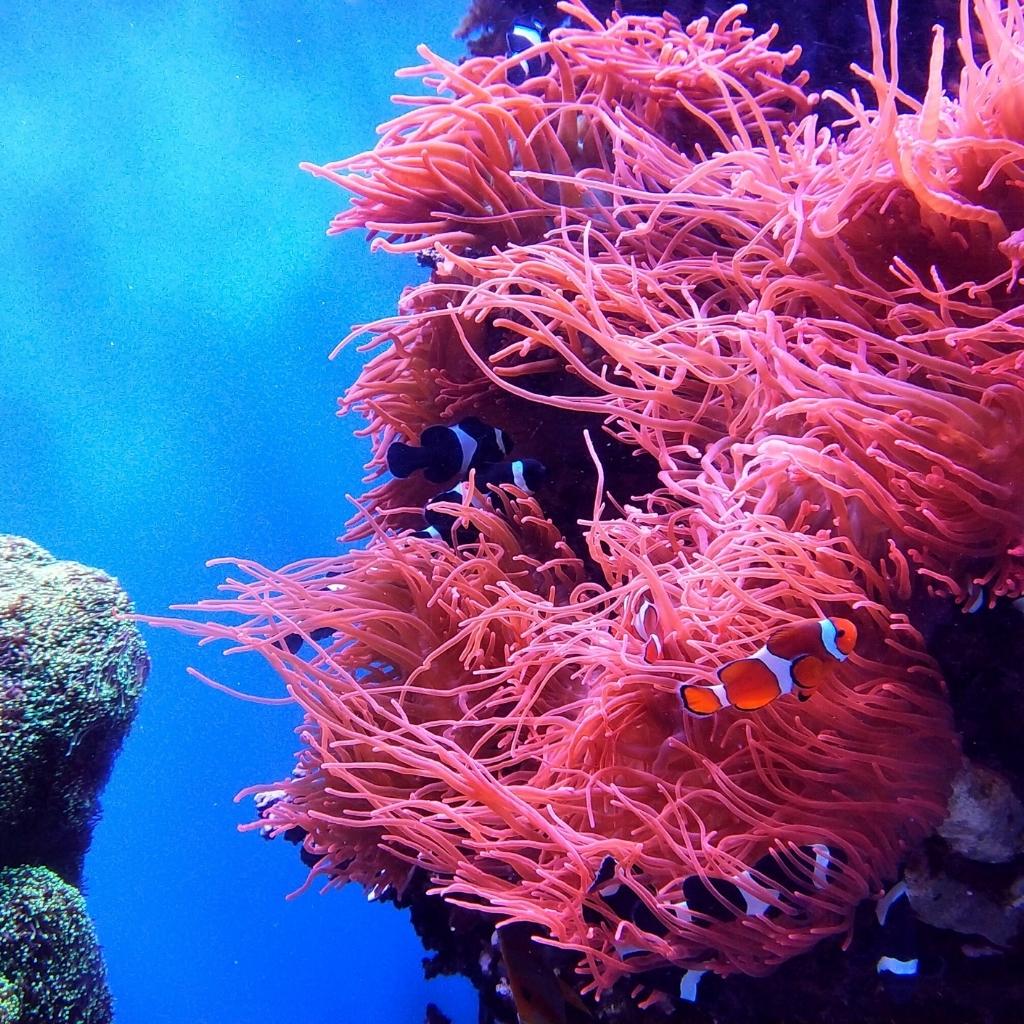This summer, keeping your family safe for the sun is priority number 1..… but you wonder… does it have to be at the cost of the ecosystem? You’ve heard the horror stories of conventional sunscreens, aka chemical sunscreens, that can hurt both your family’s health and cause damage to our coral reef ecosystems. So how can you protect your skin, and the coral reefs, without staying inside all year? The answer is natural sunscreens!
Mineral sunscreens are made without toxins, are effective against both types of sun rays, and biodegrade in water – making them safe for sea critters and people alike! Read on to learn everything you need to know about mineral vs. chemical sunscreen, and why to make the switch!
What You’ll Learn:
- What makes mineral based, reef-safe sunscreen the better option for you and the environment
- How to choose your natural sunscreen
- What chemicals are found in conventional sunscreen, and what ingredients to watch out for
Not All Sunscreens are Created Equal
Spring has sprung! The weather is warmer, summer is right around the corner, and everyone wants to be outside soaking up the sun. After a long winter, a hefty dose of vitamin D is just what the doctor ordered. However, as many of you know, the intense UV rays of the sun can cause sunburns, premature wrinkles, age spots, and freckles. Most importantly, when sunlight meets unprotected skin, it can cause cellular damage and form cancer-causing free radicals. It’s estimated that 20% of people will develop skin cancer in their lifetime, with sun exposure playing a huge role. That’s where the hero of this story comes in: sunscreen.
Sunscreen is essential to preventing sun damage, and keeping your skin looking young, healthy, and beautiful. So, what’s the problem? Not all sunscreens are created equal.

While it’s important to protect your skin from harmful UV rays, there’s an abundance of toxic chemicals living in traditional sunscreens that can cause all sorts of problems. What you put on your skin gets absorbed into your skin, so show some self love and don’t give your body anything less than what it deserves. Not only can some of the ingredients in your average sunscreen cause an array of health problems for you, but they negatively impact marine ecosystems as well. Like our coral reefs, your body is also irreplaceable, so nurture it with good-for-you ingredients!
Conventional Chemical Sunscreens
There are a few different types of sunscreens, and chemical based protection owns a good portion of the market. You’ve seen the typical tubes and spray bottles at convenience stores and supermarkets. Most traditional sunscreens contain a chemical combo of at least two ingredients from the following list: oxybenzone, avobenzone, octisalate, octocrylene, homosalate, and octinoxate. Now try saying that five times fast (but once is hard enough)!
Some of these chemicals, such as oxybenzone, have been reported to mimic the effects of naturally occurring hormones in your body. It acts like estrogen, significantly lowering testosterone levels in men and increasing the likelihood of unbalanced hormones in women. Other chemicals in conventional sunscreens have been known to cause skin irritation, rashes, redness, itching, burning, and blisters. Nothing says Spring Break like an inflamed rash… NOT!
On top of being bad for your personal health, chemical-laden sunscreens also pose risks to coral reefs and entire marine ecosystems. Corals are composed of a calcium carbonate skeleton that houses microscopic algae. In short, the algae acts as a food source for the coral, and that’s what creates coral’s bright colors.
Drastic changes in ocean conditions can cause the coral to reject this essential algae, bleaching the coral in the process. Without their symbiotic algae buddies, coral can’t survive long term, and the basis for thriving marine ecosystems is threatened. The cause of some of this coral bleaching? You guessed it–chemical sunscreens.
Oxybenzones, a common ingredient in conventional sunscreens, have been linked to causing coral endocrine disruption, DNA damage, and death. Each year, around 14,000 tons of this toxic ingredient enters our coral reefs. This is a huge deal, as it only takes a teeny bit to cause massive damage–the equivalent of one drop of this chemical in an Olympic sized pool of water can be harmful.
But this doesn’t mean you shouldn’t wear sunscreen! Instead, the next time you’re heading out to soak up your vitamin-sea, make sure to choose a mineral-based sunscreen. Mineral-based, natural sunscreens are different because they contain the active ingredients zinc oxide and titanium dioxide, which ward off harmful rays without any links to damaging our coral reefs.
Mineral Based Sunscreen
Zinc Oxide
Mineral sunscreens work differently than chemical-based ones. Sometimes known as physical sunscreens, they use a super-white mineral called zinc oxide as the active ingredient. Instead of absorbing into your skin, zinc oxide works differently. This powerful mineral physically shields your skin, reflecting dangerous UV rays back into the atmosphere instead of letting them pass through to your skin. Studies show that zinc oxide is actually the more effective than its chemical competitors in deflecting both UVA and UVB rays!
Titanium Dioxide
Some natural sunscreens add an extra level of protection with another mineral called titanium dioxide. While zinc oxide typically does the heavy lifting when it comes to blocking UVA and UVB rays, titanium dioxide can boost the UVB protection. These two minerals are the only FDA approved active ingredients in natural sunscreen, so you’ll be able to spot natural vs. chemical just by checking the back of the bottle.
If you’re new to mineral-based sunscreens, don’t be alarmed when it doesn’t totally rub in to your skin. These white spots are a good thing, as it’s actually the sunscreen doing its job–acting as a physical barrier between your skin and the sun. Natural sunscreen doesn’t break down as easily in the sun as chemical sunscreen does, which means your skin will have a more reliable source of protection, for a longer period of time.
Choosing a Natural Sunscreen
Double-check “organic”
Now, sunscreen marketers have gotten a little tricky with the word “organic,” so don’t be fooled if you usually stick to certified organic products. Mineral based sunscreens technically can’t be labeled as 100% “organic,” since zinc oxide and titanium dioxide don’t actually contain carbon (making them, literally, “inorganic”). Other sunscreens can claim the label, however, because the active ingredients do contain carbon. It may seem odd, but in the case of sunscreens, don’t chose your products solely based off of the word organic, and instead look for zinc oxide and titanium dioxide in the “Active Ingredients” section. If you’d still like to use sunscreen that contains organic ingredients aside from the mineral components, you can look out for products labeled as “made with organic ingredients”, or that meet NSF/ANSI 305 standards (meaning they contain at least 70% organic ingredients).
Nano Nonsense
When purchasing mineral-based sunscreen, try to look for “non-nano” on the ingredients label when it comes to zinc oxide and titanium dioxide. Nano-particles are added to make the sunscreen more sheer when applied, just like a conventional chemical based sunscreen. These nano-particles might help your natural sunscreen smooth on a little easier, but it has the potential to harm marine organisms by “clogging” their cavities used for nutrient acquisition. Plus, there hasn’t been sufficient testing on the effects that absorbing these nano-particles into your skin can have, so some people choose to avoid it for their health.
Check the ingredients list
Just because a sunscreen is labeled “natural,” doesn’t mean that it has all natural ingredients. Always check the ingredients to see what else you’re rubbing on your skin. At EarthHero, we break down the ingredients for you, so you don’t have to worry!
As an added bonus, many of our favorite mineral based sunscreens contain added organic ingredients to further boost your complexion! This could be anything from organic green tea, to olive leaf essential oil for a total moisture surge. A good organic sunscreen won’t just protect you from UVA and UVB rays, it will nourish sensitive skin too. Same goes for your after-sun care–make sure it has a healthy dose of moisture in it!
A Better Alternative
We just threw a ton of information at you, and we know that choosing a natural sunscreen can seem a little complicated. Don’t fret! There are plenty of amazing brands making sunscreen that’s skin and coral reef safe. Not all sunscreens will meet all of the requirements we listed above, but by taking what you’ve learned, you’ll be able to steer away from yucky chemical-heavy, synthetic sunblocks.
Looking for a new sunscreen this summer? Here are some our favorite mineral-based brands!

All Good is committed to presenting people with a great sunscreen choice for the health of our rivers, lakes, and oceans. All waterways lead to the ocean, so it’s important to be conscious of what we’re putting into them, whether it’s a pristine mountain stream or a secluded watering hole. By keeping most of their products at ten ingredients or less and using non-nano zinc oxide-based formulas, you can know that everything in their products is, well, All Good.

Founded by an award winning female chemist and avid scuba diver, Stream2Sea isn’t a stranger to the world of eco-conscious, planet-approved ingredients. In the face of climate change and changing ocean conditions, coral reefs already have enough to worry about as it is. That’s why Stream2Sea offers biodegradable, vegan, mineral-based sunscreen composed of conscious ingredients for complete sun protection without any of the traditional toxicity concern. Plus, all their products are packaged in either sugarcane resin tubes, or 97% post-consumer recycled plastic, so you can reduce the amount of plastic in your life!
Lastly, Badger has got you covered this summer with their hydrating, nourishing, and sensitive-skin-approved line of natural sunscreen. Crafted with organic sunflower oil, beeswax, and vitamin E, this NSF-certified, non-GMO, and water-resistant lotion is perfect for any outdoor activity. On top of that, it’s reef-friendly and biodegradable, so you know you won’t be harming the planet.
Wrap It Up
It’s that time of year again when skin protection jumps to the top of the priority list. Preventing skin damage should be a concern for everyone, but it shouldn’t come at the expense of putting toxic chemicals on your body or into our waterways. When shopping for a sunscreen, try to avoid traditional chemical sunscreens all together and opt for a mineral-based lotion, and look for products with non-nano particles. We’ve shared with you our favorite brands for the health of both ourselves and our planet. What’s your go-to way to stay protected from the sun’s powerful rays?
This blog article was originally published in April 2018 and was updated in June 2023.





